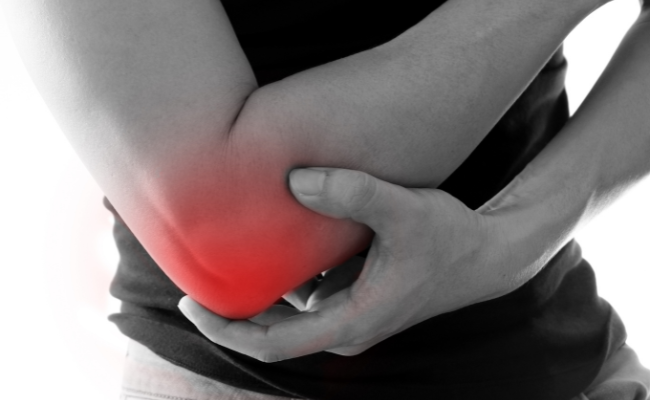How to Treat Tennis Elbow?
- January 03, 2024
- No Comments

What is Tennis Elbow?
Tennis elbow, medically known as lateral epicondylitis, is an overuse injury that manifests when tendons, connecting muscles to bones, undergo excessive strain, leading to inflammation, degeneration, and potential tearing. While the name suggests a connection to tennis, this condition is not exclusive to tennis players. It can affect individuals participating in various activities involving repetitive arm motions or gripping actions. The primary factor contributing to tennis elbow is the repetitive stress placed on the forearm muscles and tendons, resulting in microscopic tears in the tissue.
Why Does Tennis Elbow Occur?
The development of tennis elbow is rooted in the repeated stress imposed on the forearm tendons, particularly the extensor tendons that connect to the lateral epicondyle (the bony bump on the outer part of the elbow). Activities involving gripping, twisting, or lifting can lead to microscopic tears in the tendons, initiating an inflammatory response. Common contributors include playing tennis, using hand tools, typing, or engaging in certain occupational tasks. Over time, the cumulative effect of these activities can lead to persistent pain and discomfort.
How Does Tennis Elbow Manifest?
The symptoms of tennis elbow typically include pain, weakness, stiffness, and tenderness in the affected arm. Pain is often localized to the outer part of the elbow and can intensify during gripping or lifting activities. Weakness in the affected arm makes it challenging to perform daily tasks, while stiffness may be experienced after periods of rest. Tenderness to touch over the lateral epicondyle is a common characteristic, indicative of the inflammation affecting the tendons.
The onset of symptoms is gradual, and if the underlying cause is not addressed, the condition can worsen over time, leading to increased pain and functional limitations.
Treatment Solutions for Tennis Elbow
Effectively managing tennis elbow requires a multifaceted approach that addresses the underlying causes, provides symptomatic relief, and prevents recurrence.
- Rest and Activity Modification: The cornerstone of tennis elbow treatment is rest. Allowing the damaged tendons time to heal is crucial. This involves minimizing or avoiding activities that exacerbate symptoms, such as repetitive gripping. Modifications in gripping techniques and the use of ergonomic tools can reduce strain on the affected tendons.
- Ice and Compression: Applying ice to the affected area helps reduce inflammation and alleviates pain. Compression with a bandage or brace provides additional support and minimizes swelling. This combination of cold therapy and compression is an integral part of the initial management of tennis elbow.
- Physical Therapy: Physical therapy plays a pivotal role in the rehabilitation of tennis elbow. Skilled therapists design exercise programs to strengthen the forearm muscles, improve flexibility, and correct any biomechanical issues contributing to the condition. Techniques such as massage and ultrasound may also be employed to enhance healing.
- Medications: Nonsteroidal anti-inflammatory drugs (NSAIDs), such as ibuprofen, can be used to manage pain and reduce inflammation. In cases of more severe or persistent symptoms, corticosteroid injections may be considered to provide localized anti-inflammatory effects.
- Brace or Splint: Wearing a brace or splint can offer support to the affected arm, reducing strain on the injured tendons. This is particularly beneficial during activities that may exacerbate symptoms or when additional support is needed.
- Extracorporeal Shock Wave Therapy (ESWT): For cases resistant to conservative measures, ESWT may be considered. This non-invasive procedure utilizes shock waves to stimulate healing in the affected tendons.
Benefit Points:
- Early Intervention for Faster Recovery: Seeking early intervention is crucial for faster recovery. Prompt treatment initiation significantly improves outcomes and reduces the risk of severe complications.
- Reduced Pain and Improved Function: Treatment strategies, including rest, physical therapy, and medications, aim to reduce pain and improve the overall function of the affected arm. Addressing the symptoms contributes to enhanced quality of life during the course of the illness.
- Prevention of Chronicity: Effective management helps prevent the progression of tennis elbow to a chronic condition, reducing the likelihood of long-term disability. Early recognition and intervention play a pivotal role in preventing chronicity.
- Customized Rehabilitation: Physical therapy offers customized rehabilitation plans tailored to individual needs. These plans address specific weaknesses and promote optimal recovery. The focus on individualized care contributes to better overall outcomes.
- Comprehensive Approach for Long-Term Relief: Adopting a comprehensive approach to tennis elbow treatment, including lifestyle modifications and ergonomic adjustments, enhances the likelihood of long-term relief. A holistic strategy not only addresses immediate symptoms but also reduces the risk of recurrence.
Comments (0)